
A tornado is a violently rotating column of air that is in contact with both the surface of the Earth and a cumulonimbus cloud or, in rare cases, the base of a cumulus cloud. It is often referred to as a twister, whirlwind or cyclone, although the word cyclone is used in meteorology to name a weather system with a low-pressure area in the center around which, from an observer looking down toward the surface of the Earth, winds blow counterclockwise in the Northern Hemisphere and clockwise in the Southern. Tornadoes come in many shapes and sizes, and they are often visible in the form of a condensation funnel originating from the base of a cumulonimbus cloud, with a cloud of rotating debris and dust beneath it. Most tornadoes have wind speeds less than 180 kilometers per hour, are about 80 meters across, and travel several kilometers before dissipating. The most extreme tornadoes can attain wind speeds of more than 480 kilometers per hour (300 mph), are more than 3 kilometers (2 mi) in diameter, and stay on the ground for more than 100 km (62 mi).

A supercell is a thunderstorm characterized by the presence of a mesocyclone, a deep, persistently rotating updraft. Due to this, these storms are sometimes referred to as rotating thunderstorms. Of the four classifications of thunderstorms, supercells are the overall least common and have the potential to be the most severe. Supercells are often isolated from other thunderstorms, and can dominate the local weather up to 32 kilometres (20 mi) away. They tend to last 2–4 hours.

Storm chasing is broadly defined as the deliberate pursuit of any severe weather phenomenon, regardless of motive, but most commonly for curiosity, adventure, scientific investigation, or for news or media coverage. A person who chases storms is known as a storm chaser or simply a chaser.

Timothy Patrick Marshall is an American structural and forensic engineer as well as meteorologist, concentrating on damage analysis, particularly that from wind, hail, and other weather phenomena. He is also a pioneering storm chaser and was editor of Storm Track magazine.

The rear flank downdraft (RFD) is a region of dry air wrapping around the back of a mesocyclone in a supercell thunderstorm. These areas of descending air are thought to be essential in the production of many supercellular tornadoes. Large hail within the rear flank downdraft often shows up brightly as a hook on weather radar images, producing the characteristic hook echo, which often indicates the presence of a tornado.
Neil Burgher Ward was an American meteorologist who is credited as the first scientific storm chaser, developing ideas of thunderstorm and tornado structure and evolution as well as techniques for forecasting and severe weather intercept. He also was a pioneering developer of physical models of tornadoes, first at his home, then at the National Severe Storms Laboratory (NSSL) in Norman, Oklahoma. He significantly furthered the modern scientific understanding of atmospheric vortices, particularly tornadoes.
Convective storm detection is the meteorological observation, and short-term prediction, of deep moist convection (DMC). DMC describes atmospheric conditions producing single or clusters of large vertical extension clouds ranging from cumulus congestus to cumulonimbus, the latter producing thunderstorms associated with lightning and thunder. Those two types of clouds can produce severe weather at the surface and aloft.
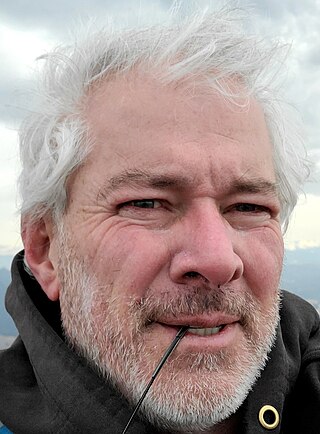
Joshua Michael Aaron Ryder Wurman is an American atmospheric scientist and inventor noted for tornado, tropical cyclone, and weather radar research, the invention of DOW and bistatic radar multiple-Doppler networks.

The Verification of the Origins of Rotation in Tornadoes Experiment are field experiments that study tornadoes. VORTEX1 was the first time scientists completely researched the entire evolution of a tornado with an array of instrumentation, enabling a greater understanding of the processes involved with tornadogenesis. A violent tornado near Union City, Oklahoma was documented in its entirety by chasers of the Tornado Intercept Project (TIP) in 1973. Their visual observations led to advancement in understanding of tornado structure and life cycles.
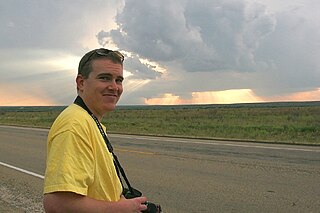
Eric Michael Nguyen was an American professional storm chaser, meteorologist, and photographer from Keller, Texas, United States. In 2008, Nguyen released his first book of photography titled Adventures in Tornado Alley: The Storm Chasers with co-author Mike Hollingshead.

The 2013 El Reno tornado was an extremely large and powerful tornado that occurred over rural areas of Central Oklahoma during the early evening of Friday, May 31, 2013. This rain-wrapped, multiple-vortex tornado was the widest tornado ever recorded and was part of a larger weather system that produced dozens of tornadoes over the preceding days. The tornado initially touched down at 6:03 p.m. Central Daylight Time (2303 UTC) about 8.3 miles (13.4 km) west-southwest of El Reno, rapidly growing in size and becoming more violent as it tracked through central portions of Canadian County. Remaining over mostly open terrain, the tornado did not impact many structures; however, measurements from mobile weather radars revealed extreme winds in excess of 135 m/s within the vortex. These are among the highest observed wind speeds on Earth, just slightly lower than the wind speeds of the 1999 Bridge Creek–Moore tornado. As it crossed U.S. 81, it had grown to a record-breaking width of 2.6 miles (4.2 km), beating the previous width record set in 2004. Turning northeastward, the tornado soon weakened. Upon crossing Interstate 40, the tornado dissipated around 6:43 p.m. CDT (2343 UTC), after tracking for 16.2 miles (26.1 km), it avoided affecting the more densely populated areas near and within the Oklahoma City metropolitan area.
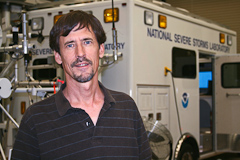
Erik Nels Rasmussen is an American meteorologist and leading expert on mesoscale meteorology, severe convective storms, forecasting of storms, and tornadogenesis. He was the field coordinator of the first of the VORTEX projects in 1994-1995 and a lead principal investigator for VORTEX2 from 2009-2010 and VORTEX-SE from 2016-2017, as well as involved in other smaller VORTEX offshoots and many field projects.

Paul M. Markowski is an American meteorologist and leading expert on tornadogenesis and the forecasting of supercells and tornadoes.
The following is a glossary of tornado terms. It includes scientific as well as selected informal terminology.
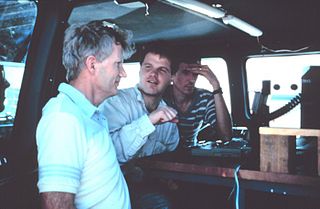
Jerry Michael Straka is an American atmospheric scientist with expertise microphysics of clouds, cloud modeling, and dynamics of severe convection in conjunction with weather radar. He was in leadership roles in both the VORTEX projects and subsequent field research focusing on tornadogenesis.

Donald W. Burgess is an American meteorologist who has made important contributions to understanding of severe convective storms, particularly tornadoes, radar observations and techniques, as well as to training other meteorologists. He was a radar operator during the first organized storm chasing expeditions by the University of Oklahoma (OU) in the early 1970s and participated in both the VORTEX projects.

Yvette Richardson is an American meteorologist with substantial contributions on tornado dynamics, tornadogenesis, the environments of tornadoes, supercells, and severe convection, and radar observations of these. She was a principal investigator (PI) of VORTEX2.
David C. Dowell is American atmospheric scientist recognized for research on tornado structure and dynamics and on tornadogenesis. He participated in both of the VORTEX projects.
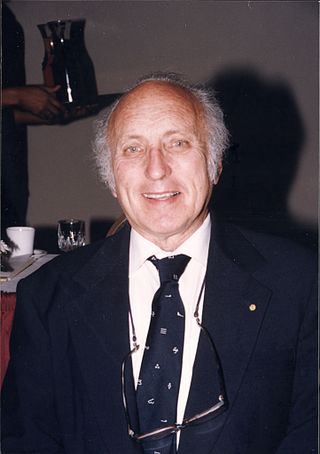
Edwin Kessler III was an American atmospheric scientist who oversaw the development of Doppler weather radar and was the first director of the National Severe Storms Laboratory (NSSL).

The RapidX-bandPolarimetric Radar, commonly abbreviated as RaXPol, is a mobile research radar designed and operated by the University of Oklahoma, led by Howard Bluestein. RaXPol often collaborates with adjacent mobile radar projects, such as Doppler on Wheels and SMART-R. Unlike its counterparts, RaXPol typically places emphasis on temporal resolution, and as such is capable of surveilling the entire local atmosphere in three dimensions in as little as 20 seconds, or a single level in less than 3 seconds.
















